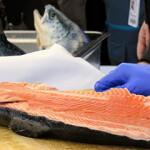Camanchaca posts strong Q3 results
Chilean salmon farmer Camanchaca said an increase in the harvest and sale of salmon during the third quarter of 2018, along with improved sanitary conditions for Atlantic salmon, led to an increase in many of its financial metrics.
Revenue for the quarter increased 59.7 percent year-over-year to reach USD 156.7 million (EUR 137.6 million) in the quarter. Revenues for the accumulated nine months of 2018 reached USD 482 million (EUR 423 million), a 47 percent increase compared to the same period last year.
Its gross margin for the nine-month period (before Fair Value) was USD 101 million (EUR 88.7 million), a 63 percent increase over the same period last year. For the third quarter, the gross margin before Fair Value was 107 percent, reaching UDD 26 million (EUR 22.8 million) for these three months.
EBITDA reached USD 74 million (EUR 64.9 million) in the first nine months of the year, a 143 percent increase over the same period in 2017, and 15.5 percent of its income. Salmon EBITDA increased 50 percent to USD 21.3 million (EUR 18.7 million), while its wild capture fishing business saw its EBITDA more than triple due to improved climatic conditions over 2017. Anchovy landings increased 15 percent in the nine-month period, totaling 85,00 tons, due to this improved climatic scenario. This led to a 16 percent increase in the sale of fishmeal and a 160 percent increase in fish oil, which both saw price improvements over 2017.
Sales volumes of salmon increased 109 percent over the first nine months, due to a 93 percent increase in its harvests for the period – 35,000 tons WFE – and the sale of its inventories that existed in the beginning of 2018.
Atlantic salmon prices did fall, though, down 7.9 percent on average in the first nine months of the year. However, improved production scale and efficiency measures allowed the company to keep its EBIT per kilogram WFE decrease to only 8 cents, reaching USD 1.22/kg WFE.
The percentage of sales coming from the US market fell to 45.8 percent in the nine month period, down from 58.3 percent in the same period last year. Sales to Europe and Eurasia, mostly Russia, increased from 6.3 percent in the first nine months of 2019 to 22.5 percent in the same period this year.






Share